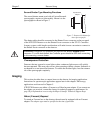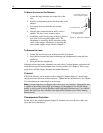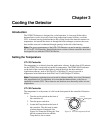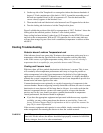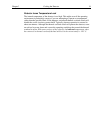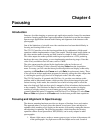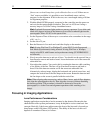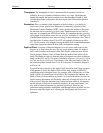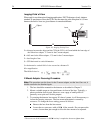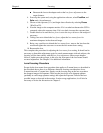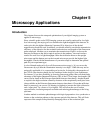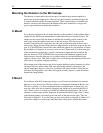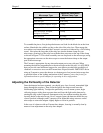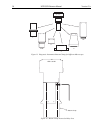
Chapter 4 Focusing 23
Throughput:
The throughput of a lens is determined by its aperture, which can
ordinarily be set to a number of different values, or f/ stops. The higher the
number the smaller the aperture and the lower the throughput. Depth of field
considerations make it imperative that focusing be done at maximum aperture
(smallest f/).
Resolution:
This is a measure of the sharpness of the lens, that is, of its ability to
resolve two closely spaced lines. Resolution is commonly expressed as the
Modulation Transfer Function (MTF), which specifies the number of line pairs
per mm that can be resolved for a given valley depth between the two lines of
each pair. In comparing the MTF of two lenses, it is important that the specified
valley depth for both be the same. For any real lens, resolution is a function of f/,
with maximum sharpness most often occurring at some mid-range value. Thus, a
lens that offers f/ settings from f/2.8 to f/22 will probably be sharpest at f/8 or
f/11. For this reason, even though focusing should be done at maximum aperture,
actual data acquisition should be done with a mid-aperture setting.
Depth of Field:
A measure of how the sharpness of a lens varies with respect to the
distance of an object from the lens. For any given aperture, there is a depth of
field, usually marked on the barrel of the lens. Objects within the zone will be
sharply imaged. Objects closer or further than the depth of field will not be as
sharp. The further an object is from the point of sharpest focus, the less sharp its
image on the CCD will be. The point of maximum sharpness is located 1/3 of the
way into the depth of field zone. For example, if the indicated depth of field for
the selected aperture extends from 3 ft to 6 ft, the point of maximum sharpness
will be at 4 ft.
For good focusing sensitivity, the depth of field should be small (large aperture).
If the aperture is small, the depth of field will be deep, making it difficult to
establish the point of sharpest focus. For example, with a 50 mm lens, at f/4 the
depth of field will extend from 8 ft to infinity. By focusing at full aperture, the
depth of field will be as shallow as possible. As a result, the effects of even very
small focusing adjustments will be readily observed, allowing the focus to be set
with precision. Once the optimum focus setting has been achieved, the aperture
can be reduced to the point of maximum sharpness. In some experiments, you
may wish to adjust the aperture for optimum signal level. However, the
experiment setup parameters established with the applications software can also
be used to adjust the signal level, allowing the lens aperture and focus to be
optimized.



